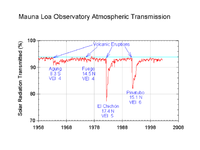
Photo from wikipedia
To assess the impact of anthropogenic aerosol emission reduction on limiting global temperature increase to 1.5 °C or 2 °C above pre-industrial levels, two climate modeling approaches have been used… Click to show full abstract
To assess the impact of anthropogenic aerosol emission reduction on limiting global temperature increase to 1.5 °C or 2 °C above pre-industrial levels, two climate modeling approaches have been used (MAGICC6, and a combination of ECHAM-HAMMOZ and the UVic ESCM), with two aerosol control pathways under two greenhouse gas (GHG) reduction scenarios. We found that aerosol emission reductions associated with CO2 co-emissions had a significant warming effect during the first half of the century and that the near-term warming is dependent on the pace of aerosol emission reduction. The modeling results show that these aerosol emission reductions account for about 0.5 °C warming relative to 2015, on top of the 1 °C above pre-industrial levels that were already reached in 2015. We found also that the decreases in aerosol emissions lead to different decreases in the magnitude of the aerosol radiative forcing in the two models. By 2100, the aerosol forcing is projected by ECHAM–UVic to diminish in magnitude by 0.96 W m−2 and by MAGICC6 by 0.76 W m−2 relative to 2000. Despite this discrepancy, the climate responses in terms of temperature are similar. Aggressive aerosol control due to air quality legislation affects the peak temperature, which is 0.2 °C–0.3 °C above the 1.5 °C limit even within the most ambitious CO2/GHG reduction scenario. At the end of the century, the temperature differences between aerosol reduction scenarios in the context of ambitious CO2 mitigation are negligible.
Journal Title: Environmental Research Letters
Year Published: 2018
Link to full text (if available)
Share on Social Media: Sign Up to like & get
recommendations!